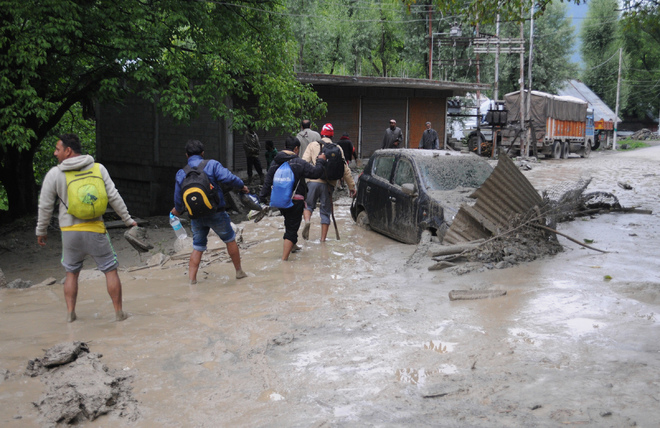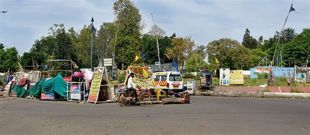
Amarnath pilgrims walk through mud after a cloudburst along the Srinagar-Leh national highway. Tribune file Photo
Majid Jahangir
Tribune News Service
Srinagar, July 19
Residents of Kashmir, where the September 2014 flooding caused widespread destruction, have now become apprehensive of slightest change in weather — even slightest downpour.
With tragic memories of floods still haunting the people followed by three flood threats issued this year, the interest in weather forecasts and future warning in the region has increased.
Kashmir has been witnessing extreme weather conditions such as excessive rain, wintry summer, rising winter temperature, increasing hailstorms and cloudbursts. Scientists say the peculiar weather pattern in the Valley is due to climate change, which is hitting almost all sectors in the region.
“The indicators of climate change in the region are loud and clear,” noted scientist and head of the earth sciences department at Kashmir University Shakil Romshoo. “Climate change has not happened overnight, but it had started much earlier,” he added.
Romshoo says the region is seeing winters getting prolonged with less snowfalls while the average minimum and maximum temperatures are showing statistically significant increasing trends for winter months and the precipitation is showing decreasing trends.
Kashmir has been witnessing a dry 40-day “Chillai Kalan”- the harshest winter period in the region. In the past, Kashmir used to witness heavy snow during Chillai Kalan. Snow used to convert into ice and stay for a longer period. This year, Kashmir witnessed heavy rains in March and June that triggered flood panic.
The Kashmir valley, as per the records of the past 100 years, used to receive one metre of snow in plains earlier, but now it is only a few inches. The decline in snow is attributed to the global warming.
The implications of this apparent climate change are seen with decreasing snowfall, receding glaciers, increasing temperatures and decreasing precipitation.
“The 50-year data indicates that the temperatures both maximum and minimum have increased,” Romshoo said.
However, the minimum temperatures have increased at an average of .7 °C to 1.1 °C in the past 100 years and globally the temperature has increased between .6 °C to .7 °C,” he added.
The data maintained by the Climate Change Centre in J&K shows that the average temperatures were rising in all six stations in the Kashmir region which are being monitored by officials in the Valley.
“The annual mean maximum temperature is increasing over Kashmir from 0.01 to 0.05 °C per year,” coordinator Climate Change Centre in J&K Majid Farooq while quoting the Indian Meteorological Department data said.
Experts say there was no major change in the precipitation over the years, but there was a change in its form. “The precipitation has not changed though there has been a slight decline, but the form of precipitation has changed significantly,” Romshoo added.
Similarly, the stream discharge, comprising predominantly snow and glacier melt, is showing a statistically significant declining trend despite melting of these glaciers.
Farooq said the region was vulnerable to the extreme weather conditions which were witnessed last year during the floods.
Director of the state’s Meteorological Department Sonam Lotus said, “Though the indicators of climate change are very clear in region, but we should not attribute every event like gusty winds and spell of rains to it. The climate change is a very complex issue.”
A paper published earlier this month in one of the top-ranking international journals in climate sciences, authored by Irfan Rashid, Assistant Professor, Earth Sciences, at Kashmir University and co-workers on “Projected climate change impacts on vegetation distribution over Kashmir Himalayas”, mapped the current vegetation distribution in the Kashmir Himalayas and projected its evolution under the changing climate.
According to the model projections, grasslands and deciduous forests in the Kashmir region would be severely affected, while savannah (hot, seasonally dry grassland with scattered trees), shrub land, temperate evergreen broadleaf forest and mixed forest types would colonise the areas currently under the cold desert/rock/ice land cover types.
“The model predicted that a substantial area of land, currently under the permanent snow and ice cover, will disappear by the end of the century which might severely impact stream flows, agricultural productivity and biodiversity in the region,” the paper read.
Farooq Ahmed Lone, group leader, Centre for Climate Change and Mountain Agriculture at Sher-e-Kashmir University of Agricultural Sciences and Technology of Kashmir (SKUAST), said, “The agriculture sector is one of the most important casualty of the changing climatic pattern.”
“Erratic weather behaviour during summer and precipitation after intense heat allows many insect and fungal pathogens to attack on the apple cop. Alternaria is one such example which devastated significant apple orchards last year. Similarly, high humidity during August September makes paddy vulnerable to blast disease. Last year, our prized crop saffron suffered huge losses due to the fall in night temperature during the September floods. Dry weather spell during Feb-March favours insect infestations such as Sanjose scale on apple whereas rainy and wet summer favours scab and other pathogenic attacks,” Lone said.
“We can adopt some strategies to minimise the effect of the climate change. We need to focus on developing climate smart crops in future which can withstand weather vagaries,” he added.



























